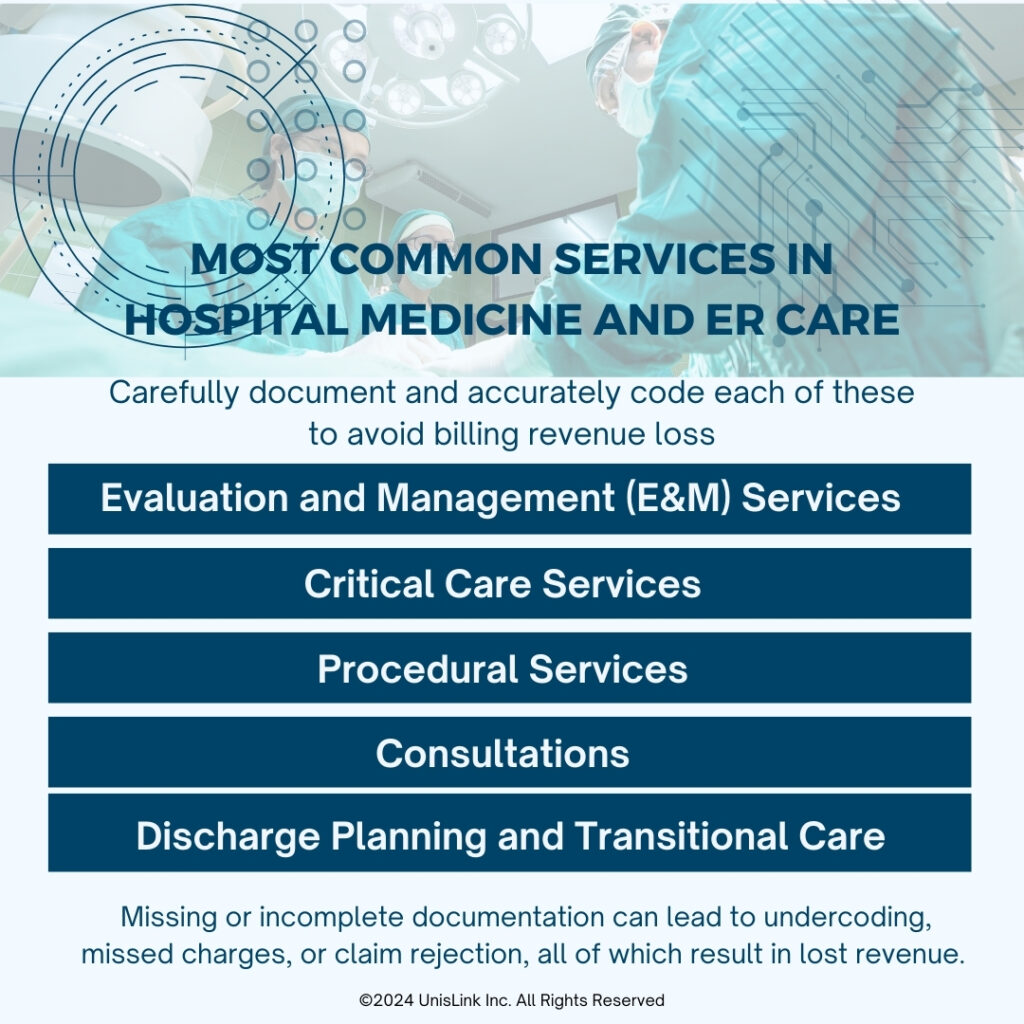How to Avoid Revenue Losses from Medical Coding Errors
Hospitalists and emergency room (ER) physicians continually oversee and manage a critical landscape of patient care in the hospital environment, where fast decision-making is an hourly challenge. Within this responsibility of diagnosis and treatment lies another vital, yet often under-valued facet of the business of healthcare delivery: medical coding.
Inaccurate medical coding can result in significant lost revenue, jeopardizing the financial well-being of both hospitals and individual practitioners. This is particularly true for those navigating blended care categories, where the intricacies of inpatient and emergency medicine converge, demanding meticulous attention to capture the complexity of diagnoses and procedures.
Appropriate billing for professional services in a hospital environment is dependent on the correct identification and classification of medical services delivered. Accurate medical coding is a crucial step in this process, translating patient encounters into standardized codes that ensure healthcare providers are appropriately reimbursed.
In the hospital environment, Hospitalists and ER doctors are typically dealing with time-sensitive, high-stakes scenarios that require immediate decisions and treatments. But without corresponding accurate documentation and coding, much of the revenue tied to their essential services can be lost or delayed.
Overview of Medical Coding for Hospital Professional Services, Hospitalists, and ER Doctors
Hospitalists are physicians who primarily provide care for hospitalized patients, while ER doctors focus on acute care in emergency departments. Although they operate in different environments, there is significant overlap in their roles, particularly when it comes to patient transitions from the emergency department to inpatient care. As healthcare systems increasingly look for cost-effective, streamlined operations, hospitalists and ER doctors often work together in managing patient flow, continuity of care, and discharge planning.
This blending of roles leads to complexities in coding, as hospitalists may be involved in both the admission and discharge of patients, while ER doctors handle the initial diagnosis and stabilization of acute conditions. Accurate coding is crucial in this context because it affects how hospitals and individual practitioners are reimbursed for their respective services, including emergency procedures, inpatient stays, and consultations.
Practitioners in the Hospital Environment Face Unique Coding Challenges
The blended roles of hospitalists and ER doctors introduce unique complexities into the revenue cycle, from initial registration to final billing. Below are some of the key challenges these professionals face:
Hospital Registration
The foundation of the revenue cycle begins with hospital registration. Compromised or inaccurate patient registration can lead to billing errors, delays in reimbursement, or denials of claims. Hospitalists and ER doctors often face incomplete or incorrect information during registration, particularly in emergency scenarios where speed is a priority. These inaccuracies can ripple through the entire billing process, severely affecting revenue collection.
Time Pressure and High Patient Volumes
ER doctors and hospitalists often deal with high patient volumes and time-sensitive care, which can lead to incomplete documentation and coding errors
Complex Coding Requirements
Both hospitalists and ER doctors deal with a wide range of medical services that require highly specific codes. These services often involve multiple diagnoses, complex procedures, and acute care management, which need precise coding to ensure proper billing. The coding complexity is exacerbated by changing guidelines and different coding practices between hospital inpatient care and emergency care. For example, transitioning patients from the ER to an inpatient setting often introduces opportunities for errors in documentation and coding.
Complexity of Diagnoses
Many patients in hospitals and ER settings present with multiple conditions. Accurately coding for all diagnoses and procedures requires detailed documentation, which may be overlooked during high-pressure situations.
Transitions of Care
Coding errors often occur when patients are transferred from one department to another, such as from the emergency room to an inpatient bed. Gaps in communication and documentation between ER doctors and hospitalists can lead to missed or incorrect coding opportunities.
Charge Capture & Reconciliation
Accurate charge capture and chart reconciliation are vital for avoiding lost revenue. Every service, procedure, and treatment provided by hospitalists and ER doctors must be properly documented and coded. However, the fast-paced nature of their work can lead to incomplete or missed charge capture. When services aren’t fully captured or reconciled with corresponding charts, the result is underbilling or claim denials, both of which contribute to revenue loss.
Shortage of Qualified Staff
The healthcare industry faces a critical shortage of qualified medical coders and billing professionals. The increased demand for coding expertise, combined with rising patient volumes, makes it difficult to staff coding departments adequately. Additionally, training existing staff to keep up with evolving coding standards adds to operational challenges. This shortage contributes to delays in claims processing, coding errors, and overall inefficiencies in revenue cycle management.
Importance of Accurate Documentation and Collaboration
To mitigate the risk of lost revenue, accurate documentation is essential. Clear, comprehensive, and timely documentation ensures that coders have the necessary information to assign the correct codes. Hospitalists and ER doctors need to be diligent in recording not just the primary diagnosis, but all relevant comorbidities and procedures performed. Collaboration between hospitalists, ER doctors, and coding professionals is crucial for ensuring that coding accurately reflects the complexity and scope of patient care provided.
One unique challenge faced by hospitalists and ER doctors is the need to use the electronic health record (EHR) system specific to each hospital or facility, while still billing under their own Tax ID. This can create a disconnect between the documentation and billing processes, as the EHR systems may vary significantly from one institution to another in terms of user interface, coding tools, and workflows.
Hospitalists and ER doctors who work across multiple facilities must constantly adapt to these different systems, which increases the risk of documentation errors and coding inconsistencies. Additionally, while they are using the facility’s EHR, their billing is managed independently under their own Tax ID, complicating the revenue cycle. These variations can lead to delays in charge capture, coding errors, and increased administrative burden, all of which affect the accuracy of billing and can contribute to lost revenue.

Most Common Medical Services in Hospital Medicine and ER Care
Here are the most common medical services performed by hospitalists and ER doctors, which should be carefully documented and accurately coded to avoid revenue loss:
- Evaluation and Management (E&M) Services: Hospitalists and ER doctors frequently perform E&M services, which are categorized into different levels based on the complexity of the visit. Correct coding for E&M services is critical to ensure proper reimbursement.
- Critical Care Services: Hospitalists and ER doctors provide critical care services for seriously ill or injured patients. Critical care is often time-based, and accurate documentation of the time spent delivering care is essential for appropriate coding and billing.
- Procedural Services: ER doctors and hospitalists perform a variety of procedural services, from suturing wounds to inserting central lines. Each procedure has a specific CPT code, and failure to document procedures and modifiers correctly can lead to lost revenue.
- Consultations: Hospitalists may provide consultations for patients admitted by other physicians, while ER doctors may request consultations from specialists. These consultations must be coded accurately to ensure appropriate reimbursement.
Discharge Planning and Transitional Care: Hospitalists often play a key role in discharge planning, which includes coordinating follow-up care and ensuring that patients have the resources they need for recovery. Proper documentation and coding for discharge services and transitional care management are crucial to prevent revenue loss.
Most Common Hospital CPT Codes
- Hospitalists:
- 1. 99221-99223: Initial hospital inpatient care, per day, for the evaluation and management of a patient. These codes are used for the first hospital visit.
- 2. 99231-99233: Subsequent hospital inpatient care, per day, for the evaluation and management of a patient. These codes are used for follow-up visits during a hospital stay.
- 3. 99238-99239: Hospital discharge day management services. These codes are used for the final visit when a patient is discharged from the hospital.
- 4. 99291-99292: Critical care services, per hour. These codes are used for the management of critically ill or injured patients.
- 5. 99281-99285: Emergency department visits for the evaluation and management of a patient. These codes are used for patients seen in the emergency department.
- 6. 99304-99310: Nursing facility services, including initial and subsequent care for patients in a nursing facility.
- 7. 99315-99316: Nursing facility discharge services. These codes are used for the final visit when a patient is discharged from a nursing facility.
- 8. 99341-99350: Home or residence services, including initial and subsequent care for patients seen at home.
- 9. 99217-99220: Observation care discharge services. These codes are used for patients under observation status.
- 10. 99224-99226: Subsequent observation care, per day, for the evaluation and management of a patient.
- ER Docs
- 1. 99281-99285: Emergency department visits for the evaluation and management of a patient. These codes range from Level I (99281) to Level V (99285), with increasing complexity and resource use.
- 2. 99291-99292: Critical care services, per hour. These codes are used for the management of critically ill or injured patients
- 3. 93042: Rhythm electrocardiogram (EKG) interpretation and report
- 4. 12001-12018: Repair of lacerations, with codes varying based on the length and location of the laceration
- 5. 29515: Application of short leg splint (calf to foot)
- 6. 29125: Application of short arm splint (forearm to hand)
- 7. 31500: Endotracheal intubation
- 8. 23650: Treatment of shoulder dislocation
- 9. 62270: Spinal puncture (lumbar)
- 10. 10060: Incision and drainage of abscess (simple or single)
Four Most Common Medical Claim Denials: Causes and Impacts
Claim denials are a major issue in hospital medicine and emergency care, often leading to revenue losses and increased administrative workload. There are several commonalities among claim denials for hospitals, and they typically revolve around administrative inefficiencies, errors in documentation, and gaps in communication between healthcare providers, coding teams, and insurers.
Understanding the common reasons for denials and how to address them is critical for healthcare providers to improve their revenue cycle management.
Below are the most frequent causes of claim denials, along with an explanation of each issue.
1. Missing or Incomplete Documentation
One of the primary reasons for claim denials is the failure to provide complete and accurate documentation. Insufficient or missing information in medical records makes it difficult for coders to assign the appropriate codes or for payers to validate the services rendered. This often occurs in fast-paced environments like the emergency room or inpatient care, where documentation may be rushed or incomplete.
Impact: Missing or incomplete documentation can lead to undercoding, missed charges, or claim rejection, all of which result in lost revenue. In some cases, the lack of detail may also prevent claims from being resubmitted successfully, turning potential income into permanent losses.
2. Eligibility and Coverage Issues
Eligibility and coverage issues arise when a patient’s insurance is not properly verified before or during treatment. This can occur when the patient’s insurance has lapsed, is inactive, or when the provider is out of network. It can also happen if certain services aren’t covered under the patient’s plan.
Impact: Claims submitted without verifying the patient’s eligibility or coverage are often denied, leaving the provider with unreimbursed services and potentially burdening the patient with unexpected medical bills.
3. Coding Errors (Including Bundling Issues)
Coding errors, such as the use of incorrect or outdated codes, improper bundling of services, or failure to follow coding guidelines, are a common cause of claim denials. Bundling occurs when services that should be billed separately are grouped together under a single code, leading to a lower reimbursement rate or outright rejection of the claim. The reverse can happen as well where services billed separately should be bundled according to the payer contract.
Impact: Coding errors can lead to claim rejections, underpayments, or costly audits. Improper bundling often results in significantly reduced reimbursements for services that should have been billed separately, causing denials and revenue leakage.
4. Timely Filing
Every insurance provider has specific deadlines within which claims must be submitted. Failing to meet these deadlines results in claim denials, and most payers will not reconsider claims submitted past the deadline.
Impact: Late claim submissions lead to automatic denials, causing permanent revenue loss, as most payers do not allow resubmission beyond the filing window. Delayed filing also indicates inefficiencies in the provider’s billing process, potentially leading to more widespread revenue issues.
Regulations Related to Reimbursement Require Persistent Attention
Several regulations influence reimbursement and coding practices in hospital medicine and emergency care, making it essential for providers to stay compliant:
- Medicare Physician Fee Schedule (PFS) Updates: Annual updates to the PFS can affect reimbursement rates for hospitalists and ER doctors.
- Hospital Outpatient Prospective Payment System (HOPPS): This system sets the rates for outpatient services, influencing ER reimbursements.
- 340B Drug Reimbursement: Hospitals purchasing drugs at reduced prices through the 340B program must comply with specific coding and billing rules.
- Quality Reporting Requirements (MIPS): Failure to comply with MIPS quality measures can result in reduced Medicare reimbursements.

AI-Automated Medical Coding Solves Common Challenges in Hospital-Based Medicine
The integration of AI-automated medical coding systems has emerged as a transformative solution for hospital-based challenges in accurate medical coding. These advanced systems are designed to streamline the coding process, enhance accuracy, and minimize the revenue loss associated with common challenges in documentation, claim submission, and compliance.
Below is an in-depth look at how AI-automated medical coding addresses many of the key problems outlined above.
Increased Accuracy and Error Reduction
One of the most significant benefits of AI-automated medical coding is its ability to drastically reduce coding errors. As discussed, hospitals frequently experience coding inaccuracies due to the complexity of medical services, the evolving nature of coding guidelines, and the high-pressure environment in which healthcare providers work.
AI-powered systems analyze patient documentation in real-time and automatically suggest appropriate codes based on the information provided. By cross-referencing the diagnosis, procedures, and treatment plans with the latest coding standards (e.g., ICD-10, CPT), the system ensures that the correct codes are applied.
This reduces the risk of undercoding, overcoding, or incorrect bundling of services, leading to more accurate claims and a lower likelihood of denials. Additionally, these systems can highlight discrepancies between documentation and coding, prompting healthcare providers to fill in gaps before the claim is submitted. In this way, AI-automated coding minimizes revenue loss due to missed or incorrect codes.
Faster Claim Submission and Reduced Administrative Burden
Manual coding is often a time-consuming process that can delay claim submission, particularly in busy hospital settings where large volumes of patient data must be processed quickly. AI-automated coding significantly accelerates this process by scanning through patient records and applying the appropriate codes in seconds. This reduces the administrative burden on human coders and billing teams, allowing them to focus on more complex or high-priority cases.
Faster coding directly translates into faster claim submission, helping hospitals meet timely filing deadlines and avoid claim denials due to late submissions. This streamlined process improves cash flow by reducing delays in reimbursement, while also lowering operational costs associated with manual claim processing.
Improved Compliance with Evolving Regulations
Hospitalists and ER doctors, in particular, face difficulties in maintaining compliance, given the frequent updates to coding requirements from entities such as CMS (Centers for Medicare & Medicaid Services) and commercial payers. AI-automated coding systems are programmed to stay up-to-date with the latest regulations, ensuring that the codes applied are compliant with current standards.
This reduces the risk of claim rejections or penalties due to the use of outdated codes or failure to comply with payer requirements.
Enhanced Documentation Support
Hospitalists and ER doctors often struggle to provide detailed documentation due to time constraints or the fast-paced nature of their work. AI-automated coding systems can assist in real-time by analyzing documentation as it is entered and suggesting additional details or flags for incomplete information. For example, if a physician documents a critical care service but fails to specify the time spent, the system can prompt them to include the time component, which is essential for correct coding and billing of time-based services.
By integrating these prompts directly into the EHR workflow, AI tools help ensure that all necessary documentation is included, reducing the likelihood of missing or incomplete information leading to claim denials. This also helps bridge communication gaps between healthcare providers and coding teams, ensuring that the entire care process is fully captured in the patient’s record.
Scalability and Adaptability Across Multiple Facilities
As noted in the unique challenges section, hospitalists and ER doctors often work across multiple facilities, each with its own EHR system and workflow. AI-automated medical coding systems offer a solution by being adaptable to different environments and EHR platforms. These AI-driven tools can integrate with various EHR systems and apply standardized coding practices, regardless of the facility where the care was provided.
By automating the coding process and ensuring that providers can bill under their own Tax ID while using facility-specific EHRs, AI tools streamline the coding and billing workflow across multiple locations. This scalability ensures consistency in coding and billing practices, reducing the risk of errors or inconsistencies that might arise from using different systems.
Proactive Claim Denial Prevention
Perhaps one of the most significant benefits of AI-automated medical coding is its ability to prevent claim denials before they happen. The system can identify potential issues with a claim, such as missing documentation, incorrect codes, and alert the provider before submission. This proactive approach allows healthcare teams to correct errors early, reducing the chances of claim rejection and the need for costly and time-consuming appeals processes.
Additionally, AI systems can analyze patterns of claim denials and provide insights into recurring issues, allowing hospitals to make systemic improvements in their coding and documentation practices. This helps reduce the overall rate of denials and enhances revenue cycle management over time.
UnisLink Offers AI-Medical Coding That Solves Hospital-Based Medical Coding Challenges
UnisLink understands the challenges faced by hospitalists, ER doctors, and healthcare organizations and is reducing significant coding errors and revenue losses with its AI-powered coding solutions.
UnisLink’s advanced technology and RCM systems for hospital-based physicians can significantly reduce revenue loss and operational inefficiencies by improving accuracy, speeding up the coding process, ensuring compliance, enhancing documentation, and preventing claim denials,
As the healthcare industry continues to embrace digital transformation, AI-driven coding solutions are poised to play a crucial role in optimizing the revenue cycle, improving financial performance, and allowing healthcare providers to focus on what they do best—delivering high-quality patient care.
UnisLink is advancing in this area of AI-powered coding with new technology and seamless solutions between coding and billing that result in highly successful revenue capture for practices of all specialties.
UnisLink Delivers the Most Advanced RCM Technology
UnisLink’s advanced technology integrates seamlessly with your existing EMR/EHR, enhancing your system’s capabilities without requiring a change in platforms. Our software, combined with our expert billing services, optimizes your financial performance while allowing you to continue using your current system.
As a leader in revenue cycle management (RCM), UnisLink uniquely blends cutting-edge data analytics, automation, and personalized client support into a single, comprehensive billing solution. Our services deliver actionable insights, improve billing accuracy, reduce coding errors, and ultimately increase patient collections and overall revenue.
At the heart of UnisLink’s approach is the SmartHub™—a centralized platform powered by Artificial Intelligence (AI) and Robotic Process Automation (RPA). This hub streamlines project management, patient communications, and team collaboration. With automated tools that monitor performance, handle repetitive tasks, and drive efficiency, UnisLink SmartHub boosts the quality and productivity of every process, ensuring top-tier revenue cycle outcomes for your practice.
Contact us today for more information on hospital-based medical coding solutions and advanced RCM technology.
Article Resources:

